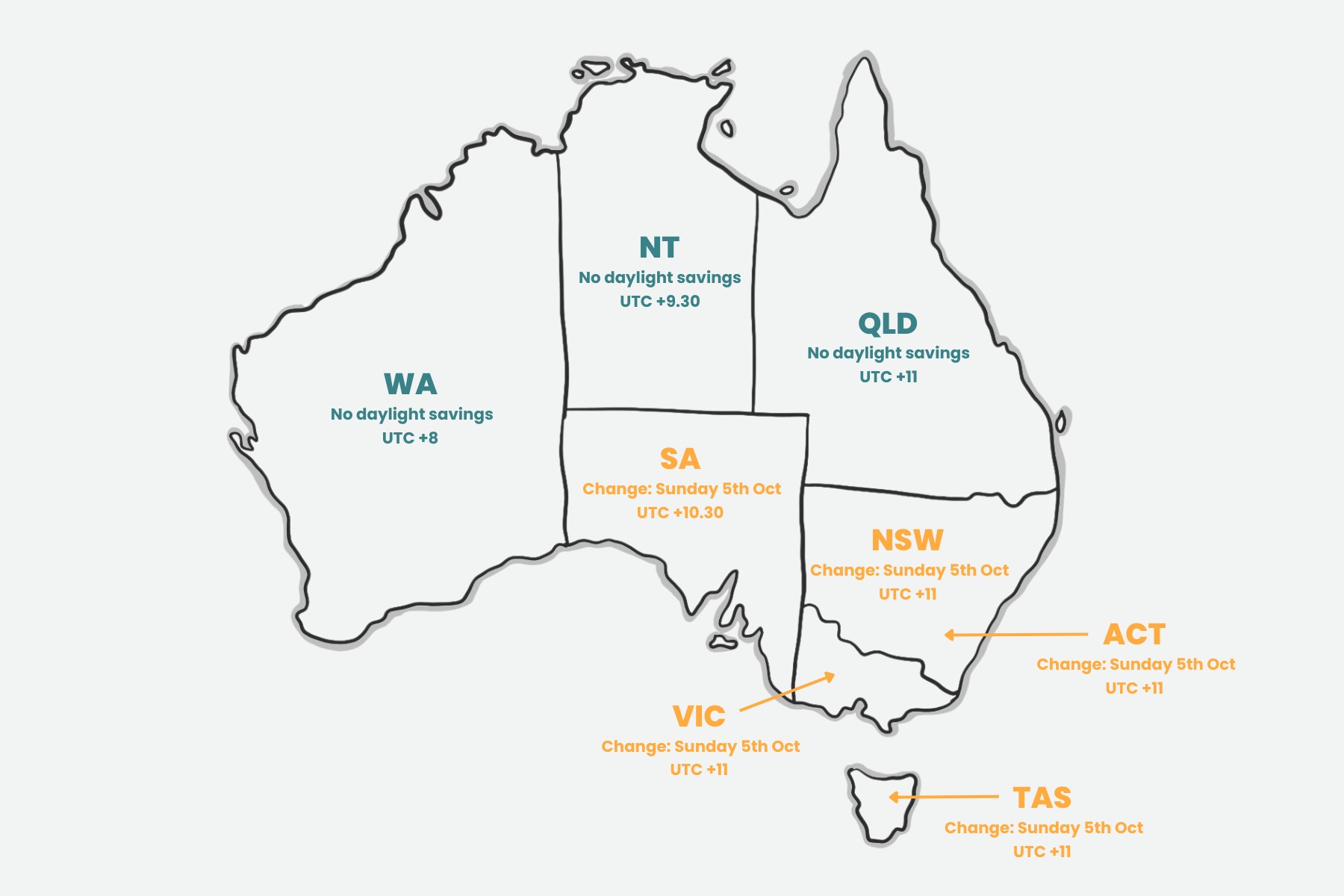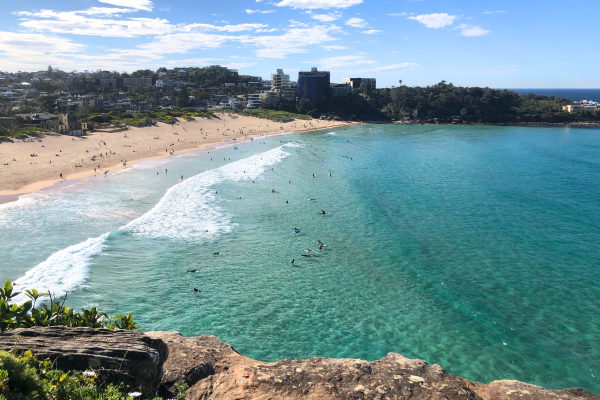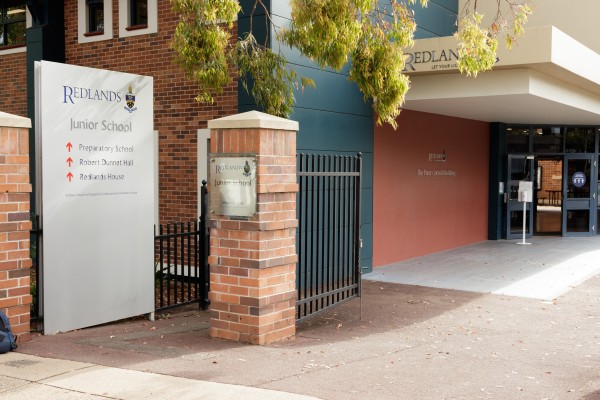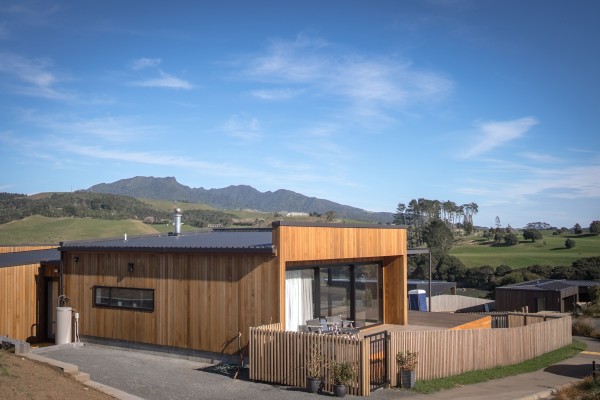Daylight Savings Australia 2025

Daylight savings may seem like a simple concept: times get adjusted to make better use of daylight during the longer days in summer. However, as is so often the case in Australia, there are varying practices across the different states and territories.
Don’t worry we’ve got you covered with everything you need to know about daylight savings Australia - no matter which part of the country you’re in.
What is daylight savings in Australia?
In Australia, daylight savings is a twice-yearly shift in time across selected states and territories. The states and territories that participate move clocks forward one hour in spring and back one hour in Autumn. The purpose of this is to maximise natural light and avoid working when it's dark.
Which states and territories observe daylight savings?
Daylight savings time (DST) is observed in some states and territories, but not all. Those that observe DST, do so from the first Sunday in October through to the first Sunday in April each year. Those that don't observe DST have no changes to their times throughout the year.
States and territories that participate in DST
States and territories that DO NOT participate in DST
Daylight savings across Australia
Wondering what day/time daylight savings kicks in in your city or state? We’ve got a complete breakdown of every state, territory and capital city in Australia.
Daylight savings Queensland
Queensland does not observe daylight savings. This means that the clocks remain unchanged throughout the year. Queensland operates in Australian Eastern Standard Time (AEST) which is equal to Coordinated Universal Time plus 10 hours (UTC +10).
Daylight savings Brisbane
Brisbane, like the rest of Queensland, don't observe Daylight Savings Time (DST). This means the times don't change throughout the year. Brisbane currently observes Australian Eastern Standard Time (AEST) which is equal to Coordinated Universal Time plus 10 hours (UTC +10).
Daylight savings New South Wales
In New South Wales daylight savings begins at 2 am Eastern Standard Time on the first Sunday in October. In 2025 this is Sunday the 5th of October. At this time clocks are moved forward by one hour, meaning 2 am will become 3 am.
At the end of daylight savings (first Sunday of April) clocks will move back an hour across NSW. In 2025 this will be on Sunday 5th April. On this day 3 am will become 2 am.
Daylight savings Sydney
In Sydney, like the rest of NSW, daylight savings commences on the first Sunday in October. In 2025 this is Sunday the 5th of October. At this time clocks are moved forward by one hour meaning 2 am will become 3 am.
At the end of daylight savings (first Sunday of April) clocks will move back an hour across Sydney. In 2025 this will be on Sunday 5th April. On this day 3 am will become 2 am.
Daylight savings Victoria
Victoria observes Daylight Savings Time (DST) from the first Sunday in October. In 2025 this is Sunday the 5th of October. At this time clocks are moved forward by one hour meaning 2 am will become 3 am.
At the end of daylight savings (first Sunday of April) clocks will move back an hour across Victoria. In 2025 this will be on Sunday 5th April. On this day 3 am will become 2 am.
Daylight savings Melbourne
In Melbourne, like the rest of Victoria, daylight savings commences on the first Sunday in October. In 2025 this is Sunday the 5th of October. At this time, clocks are moved forward by one hour meaning 2 am will become 3 am.
At the end of daylight savings (first Sunday of April) clocks will move back an hour across Melbourne. In 2025 this will be on Sunday 5th April. On this day 3 am will become 2 am.
Daylight savings ACT
ACT observes Daylight Savings Time (DST) which means from the first Sunday in October clocks will move forward by one hour. In 2025 this is on Sunday 5th October. On this day 2 am will become 3 am.
Daylight savings in ACT ends on the first Sunday of April meaning clocks will go back by one hour. In 2025 this will happen on Sunday the 5th of April at which time 3 am will become 2 am.
Daylight savings Canberra
In Canberra, like the rest of ACT, Daylight Savings Time (DST) commences on the first Sunday in October. In 2025 this will land on Sunday the 5th of October at which time clocks will move forward by one hour and 2 am will become 3 am.
Daylight savings in Canberra finishes on the first Sunday in April. In 2025 this will be Sunday the 5th April at which time the clocks will move back by one hour and 3 am will become 2 am.
Daylight savings Western Australia
Western Australia does not observe Daylight Savings Time (DST). This means the times do not change throughout the year. Western Australia currently observes Australian Western Standard Time (AWST) which is equal to Coordinated Universal Time plus 8 hours (UTC +8).
Daylight savings Perth
Perth and the rest of WA do not observe daylight changes. This means there are no changes to the time throughout the year. Perth currently observes Australian Western Standard Time (AWST) which is equal to Coordinated Universal Time plus 8 hours (UTC +8).
Daylight savings Broome
Broome and the rest of WA does not observe daylight changes. This means there are no changes to the time throughout the year. Broome currently observes Australian Western Standard Time (AWST) which is equal to Coordinated Universal Time plus 8 hours (UTC +8).
Daylight savings Northern Territory (NT)
The Northern Territory (NT) does not observe Daylight Savings Time (DST). This means times remain unchanged throughout the year and there is no need to adjust clocks like in other states and territories. NT currently observes Australian Central Standard Time (ACST) which is equal to Coordinated Universal Time plus 8 hours (UTC +9:30).
Daylight savings Darwin
Darwin, like the rest of the NT, don't observe Daylight Savings Time (DST). This means times remain unchanged throughout the year. Darwin observes Australian Central Standard Time (ACST) which is equal to Coordinated Universal Time plus 8 hours (UTC +9:30).
Daylight savings Alice Springs
Alice Springs, like the rest of the NT, don't observe Daylight Savings Time (DST). This means times remain unchanged throughout the year. Alice Springs observes Australian Central Standard Time (ACST) which is equal to Coordinated Universal Time plus 8 hours (UTC +9:30).
Daylight savings Tasmania
Daylight savings in Tasmania (TAS) commences on the first Sunday of October. On this date clocks will move forward by one hour and 2 am will become 3 am. In 2025 this Daylight Savings Time (DST) comes into effect on Sunday 5th October.
Daylight savings in TAS ends on the first Sunday of April meaning clocks will go back by one hour. In 2025 this will happen on Sunday the 5th of April, at which time 3 am will become 2 am.
Daylight savings Hobart
In Hobart, like the rest of Tasmania, daylight savings comes into effect on the first Sunday of October. On this date clocks will move forward by one hour and 2 am will become 3 am. In 2025 Daylight Savings Time (DST) comes into effect on Sunday 5th October.
In Hobart DST ends on the first Sunday of April meaning clocks will go back by one hour. In 2025 this will happen on Sunday the 5th April at which time 3 am will become 2 am.
Daylight savings South Australia (SA)
South Australia observes Daylight Savings Time (DST) which means clocks will move forward by one hour on the first Sunday of October. This change comes into effect at 2 am (2 am becomes 3 am) In 2025 this date is Sunday 5th of October.
Daylight savings in SA ends on the first Sunday of April meaning clocks will go back by one hour. In 2025 this will happen on Sunday the 5th of April at which time 3 am will become 2 am.
Daylight savings Adelaide
In Adelaide, like the rest of South Australia, Daylight Savings Time (DST) applies. This means clocks will move forward by one hour on the first Sunday of October. This change comes into effect at 2am (2am becomes 3am). In 2025 this date is Sunday 5th October.
In Adelaide DST ends on the first Sunday of April meaning clocks will go back by one hour. In 2025 this will happen on Sunday the 5th April at which time 3am will become 2am.
When did daylight savings start in Australia?
Daylight savings were initially introduced as a strategy for saving energy back in World War 1. It was then reintroduced throughout World War 2 and has been a part of Australian timekeeping ever since.
While most parts of Australia participate in daylight savings to some degree, the practice is not uniform in the slightest. Each state and territory has its own policies on the matter which has led to a mis-match of time zones across the country.
What time does daylight savings start?
In Australia, daylight savings kicks in at 2am on the first Sunday of October. The time moves forward one hour meaning 2 am becomes 3 am. On this day of the year participating states and territories effectively ‘lose’ one hour of sleep or time.
What time does daylight savings end?
In Australia, daylight savings ends at 3 am on the first Sunday in April. The time moves back one hour meaning 3 am becomes 2 am. On this day of the year, participating states and territories effectively ‘gain’ one hour of sleep or time.
What date does daylight savings kick in 2025?
Sunday, 5 October 2025 marks the beginning of daylight savings for participating states and territories. Clocks will be moved forward one hour from 2 am to 3 am.
When did daylight savings end in 2025?
Sunday 5th April 2025 marks the end of Daylight Savings Time (DST), and clocks were moved back one hour from 3am to 2am.
Do I have to change my clocks myself?
Most digital clocks such as your phone, computer or apple watch will automatically update themselves. However traditional watches, ovens and other household appliances may require a manual change.
What are the different time zones in Australia?
Australia is divided into three separate time zones:
-
Australian Eastern Standard Time (AEST)
-
Australian Central Standard Time (ACST)
-
Australian Western Standard Time (AWST)
Australian Eastern Standard Time (AEST)
Australian Eastern Standard Time (AEST) applies to Queensland, New South Wales, Victoria, Tasmania and the Australian Capital Territory.
AEST is equal to Coordinated Universal Time plus 10 hours (UTC +10)
Australian Central Standard Time (ACST)
Australian Central Standard Time (ACST) is applied in South Australia, the town of Broken Hill in western New South Wales and the Northern Territory.
ACST is equal to Coordinated Universal Time plus 9.5 hours (UTC +9.5)
Australian Western Standard Time (AWST)
Australian Western Standard Time (AWST) covers the state of Western Australia.
AWST is equal to Coordinated Universal Time plus 8 hours (UTC +8)
How do timezones change with daylight savings?
-
New South Wales, ACT, Victoria and Tasmania move from AEST to Australian Eastern Daylight Time (AEDT), UTC +11.
-
South Australia and Broken Hill move from ACST to Australian Central Daylight Time (ACDT), UTC +10.5.
Standard vs DST time zones
New South Wales (NSW)
-
Standard Time: AEST (UTC +10:00)
-
DST Time: AEDT (UTC +11:00)
Victoria (VIC)
-
Standard Time: AEST (UTC +10:00)
-
DST Time: AEDT (UTC +11:00)
South Australia (SA)
-
Standard Time: ACST (UTC +09:30)
-
DST Time: ACDT (UTC +10:30)
Tasmania (TAS)
-
Standard Time: AEST (UTC +10:00)
-
DST Time: AEDT (UTC +11:00)
Queensland (QLD)
-
Standard Time: AEST (UTC +10:00)
-
No DST Adjustment
Western Australia (WA)
-
Standard Time: AWST (UTC +08:00)
-
No DST Adjustment
Northern Territory (NT):
-
Standard Time: ACST (UTC +09:30)
-
No DST Adjustment
What is the future of daylight savings in Australia?
There is still much debate about the benefits of daylight savings. While much of Australia does not adhere to the practice, the decision to observe DST comes down to regional preferences and conditions.
Over recent years there has been much discussion around abolishment of daylight savings however, there are no clear plans to do so any time soon.
So, save this article for a quick and easy reference to daylight savings in your area and around Australia.
What do our customers say?






























